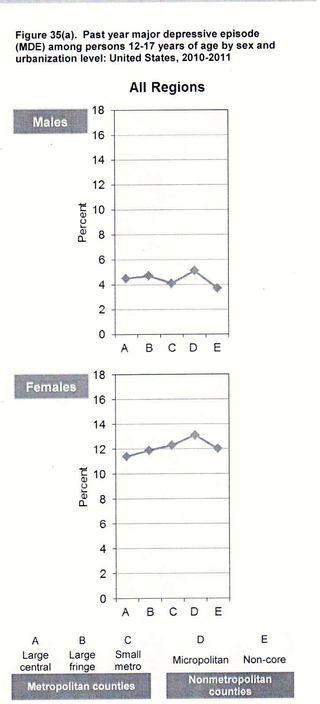Depression
Does City Life Make Us Crazy?
Actually, research shows the smaller towns have higher rates of mental illness
Posted March 22, 2016
Ever since the French poet of dissolution, Charles Baudelaire, described “the chaos of the living city” in 1857, the city has been associated with mental fragmentation and madness. The move from the healthy countryside to the dissolute city was thought to make people crazy. (Baudelaire, Les Fleurs du Mal, 1857)
But is it true? Is there something madness-making about urban life in the US in our own time? The answer seems to be no. Rather, it is smaller communities that experience higher rates of psychological distress, serious mental illness, and major depression than do the big cities.
Academic researchers assembled the statistics in the “2014 Update of the Rural-Urban Chartbook.” The question seems especially à la page because various presidential candidates have recently indicted “New York Values,” as though the values of small towns in Texas were somehow purer.
Imagine a graph line going across the page with large central cities on the left side, then data points for large fringe, small metro, micropolitan, and non-core proceeding across the page to the right. Graph lines that slant from lower left to upper right mean that the big cities are healthier: the larger the city, the more sustained the climate of mental life. A graph line slanting from upper left to lower right would mean the reverse. There are, by the way, none of these. This simply doesn’t happen.
In statistics for adults in the US, 2010-2011, there are no graphs showing that smaller communities are better for mental health than the Big Apple. To the contrary, virtually all the statistics say, the bigger the community, the better the frame of mind. This is more true for men, somewhat less true for women (whose data are harder to interpret, but on the whole, for women too, bigger is better).
Take, for example, “serious psychological distress” in the last thirty days. Senator Cruz, I’m sorry, but small towns in the South do terribly. Seven percent of the men there are distressed, 8 percent of the women. Big cities in the South, by contrast, hover at about 4 percent. (fig 36 [b])
Depression? Yup, women in almost every region were much more depressed during the past year in smaller communities than in larger. (fig 34b) And the West! Holy jeepers, living in a “micropolitan” town in that region seems to be a recipe for the blues: fully 9 percent of all adult women depressed. Women in big cities in the West by contrast, as elsewhere in the country, fare much better.
The researchers separated out statistics on depression for adolescents (12-17). The nationwide rates for adolescent males are low, around 4 percent, and show no size-of-place trend. But adolescent females are really depressed! (fig 35a) In big cities nationwide about 12 percent of them are depressed; the statistics then rise as the size of the community gets smaller.

This confirms what countless other studies have also suggested: that in adolescence, depression tends to be a female disorder.
Finally, “serious mental illness” of all kinds (33b): this would include schizophrenia. For the four major regions, and for males and females, the statistics show almost invariably the same story, Rates are lowest in the big cities, highest in smaller towns of the nonmetropolitan counties and in rural (non-core) settlements. And the trends in the South and West are very clear.
So much for all this political posturing about bringing America’s greatness back: The smaller towns, that incidentally tend to vote for the Republican Right, have disproportionately high rates mental illness.
Why do the big cities seem healthier, the smaller towns more toxic? This is sort of a chicken-and-egg proposition. Either it is that something about big-city life makes for sanity, or that the dynamic, vigorous, aggressive young men and women in the small towns move away after high school to get jobs in the big cities. Those who feel themselves more fragile, less mobilized, may be those who are left behind.
Sociology has pondered this issue for at least a century. Starting in 1890, German sociologist Georg Simmel contrasted the greater individualism and money-based social relations of the big city (Gesellschaft) with the tighter ties and coziness of the small towns (Gemeinschaft). He thought the latter healthier. This tradition has permeated social thought on the subject.
But guess what: at least for the US, in our own time, it ain’t true. Somebody tell this to the Republican candidates.




